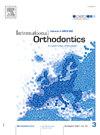3D analysis of morphological changes, maxillary central incisor–incisive canal relationship, and root resorption in subjects with maxillary incisors protrusion who underwent non-extraction fixed appliance therapy considering demographic and skeletal factors: A retrospective study
IF 1.9
Q2 DENTISTRY, ORAL SURGERY & MEDICINE
引用次数: 0
Abstract
Introduction
To assess changes in the morphology and relationship between the maxillary central incisor and incisive canal (U1-IC) and estimate root resorption following non-extraction orthodontic treatment with fixed appliances, based on sex, age, and skeletal sagittal and facial classifications.
Material and methods
All patients treated with maxillary incisors retraction using fixed appliances without extraction between 2015 and 2023 and met the inclusion criteria were included in the study. Measurements, including IC width, root-IC distance, cortical bone width (CBW), IC height, and root resorption, were taken before (T1) and after (T2) treatment at specified heights (H1, H2, and H3; 2 mm, 4 mm, and 6 mm above the labial cementoenamel junction of U1).
Results
The sample included 44 patients (88 maxillary central incisors), with 18 males, 26 females, 27 teenagers, and 17 adults. Of these, 10 were Class I, 34 Class II, 7 low facial, 27 average facial, and 10 high facial groups. Significant reductions were observed in IC width, CBW, root-IC distance, and U1 length/width after treatment, across sexes, age groups, sagittal classes, and facial groups, particularly at most heights. Class II subjects showed greater reductions in U1 root-IC distance, length, and width compared to Class I. The average root resorption was 1.01 ± 0.68 mm post-treatment, with higher resorption in males (P = 0.004), Class II (P < 0.001), and low facial groups (P = 0.007). The post-treatment U1-IC relationship showed the highest rates of approximation (68.2%) at the H2 and H3 levels, while contact and invasion rates were highest at the H1 level (13.6% and 9.1%, respectively). U1 tooth movement, U1 length, IC height, and ABO index were significant predictors of a negative U1-IC relationship.
Conclusions
Maxillary incisors retraction during fixed orthodontic treatment impacts the U1-IC relationship and root resorption, with variations across demographic and skeletal groups, underscoring the importance of considering individual anatomical and skeletal factors in treatment planning.
考虑人口统计学和骨骼因素的非拔牙固定矫治器治疗上颌前突患者的形态变化、上颌中切牙-尖根管关系和牙根吸收的三维分析
基于性别、年龄、骨骼矢状面和面部分类,评估上颌中切牙和尖根管(U1-IC)的形态变化和关系,并评估固定矫治器非拔牙正畸治疗后牙根吸收。材料与方法2015 - 2023年间所有采用固定矫治器不拔牙进行上颌门牙内收的患者均符合纳入标准。在特定高度(H1、H2和H3)处理前(T1)和处理后(T2)测量IC宽度、根-IC距离、皮质骨宽度(CBW)、IC高度和根吸收;2、4、6毫米以上的唇部牙釉质交界处U1)。结果本组患者44例(88个上颌中切牙),其中男性18例,女性26例,青少年27例,成人17例。其中,10组为ⅰ类,34组为ⅱ类,7组为低脸组,27组为平均脸组,10组为高脸组。治疗后,IC宽度、CBW、根-IC距离和U1长度/宽度显著降低,不分性别、年龄组、矢状面类别和面部组,尤其是在大多数高度。II类受试者与i类受试者相比,U1根- ic的距离、长度和宽度减小更大。治疗后平均根吸收量为1.01±0.68 mm,其中男性吸收量更高(P = 0.004);0.001),低面部组(P = 0.007)。处理后的U1-IC关系在H2和H3水平近似率最高(68.2%),而接触率和侵袭率在H1水平最高(分别为13.6%和9.1%)。U1牙移动、U1长度、IC高度和ABO指数是U1-IC负相关的显著预测因子。结论固定正畸治疗中上颌切牙内缩会影响牙根吸收和U1-IC关系,且在人口统计学和骨骼类群中存在差异,因此在制定治疗计划时应考虑个体解剖和骨骼因素。
本文章由计算机程序翻译,如有差异,请以英文原文为准。
求助全文
约1分钟内获得全文
求助全文
来源期刊

International Orthodontics
DENTISTRY, ORAL SURGERY & MEDICINE-
CiteScore
2.50
自引率
13.30%
发文量
71
审稿时长
26 days
期刊介绍:
Une revue de référence dans le domaine de orthodontie et des disciplines frontières Your reference in dentofacial orthopedics International Orthodontics adresse aux orthodontistes, aux dentistes, aux stomatologistes, aux chirurgiens maxillo-faciaux et aux plasticiens de la face, ainsi quà leurs assistant(e)s. International Orthodontics is addressed to orthodontists, dentists, stomatologists, maxillofacial surgeons and facial plastic surgeons, as well as their assistants.
 求助内容:
求助内容: 应助结果提醒方式:
应助结果提醒方式:


